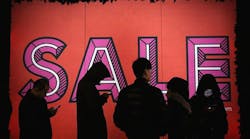Thrifty U.S. consumers carefully picked over Black Friday discounts during the four-day weekend, leaving retailers with less money in their registers and a lukewarm kickoff to the holiday season.
Though the number of shoppers grew over the weekend, the average amount they spent fell 3.5% to $289.19, including both online and offline purchases, the National Retail Federation found. Consumers shelled out $299.60 in 2015, according to the trade group, which bases its figures on surveys conducted by Prosper Insights & Analytics.
The weekend was characterized by heavy markdowns and a shift toward e-commerce, meaning there were smaller crowds at the mall. Forty-four percent of consumers did their shopping online, compared with 40% at brick-and-mortar stores. In either case, many of them were looking for just one thing: a good deal.
“Over one-third of shoppers said 100% of their purchases were on sale,” NRF Chief Executive Officer Matthew Shay said in a statement. That increased more than threefold from last year, setting an ominous tone for the rest of the holiday season -- retailers’ biggest sales period of the year.
While the total number of Black Friday weekend shoppers grew 2% to 154 million, their refusal to spend as much could renew concerns about the sluggish retail economy. Companies have been trying to bounce back from a polarizing election season that they said prevented consumers from making purchases. They were hoping a strong start to the holiday shopping season would give a boost to the industry.
Recession Mentality
But retailers also are grappling with a longer-term shift toward more thriftiness -- aided by technology.
“There’s a confluence of events here,” Shay said on a conference call Sunday. “Since the recession, we’ve had much more cost-conscious consumers. In the last six to seven years, people have been much more deliberate about the purchases they’ve made. And that coincided with the ability to access information in a very transparent way because of the existence of smartphones and technology-enabled pricing.”
Moreover, e-commerce has reduced the need to buy gifts on Black Friday weekend itself. Online sellers are doing more promotions either before or after the four-day stretch. EBay Inc., for instance, urged Thanksgiving travelers to buy things on their phones while in transit, dubbing the event “Mobile Wednesday.”
Black Friday weekend is followed by Cyber Monday, a push for e-commerce shoppers. More than 122 million consumers plan to take part, up from 121 million last year, the NRF said.
‘Cyber Week’
Brick-and-mortar chains have become more aggressive in chasing online customers. Wal-Mart Stores Inc. kicked off its “Cyber Week” promotions on Friday, and Target Corp. has been offering 15 percent off all purchases -- either in stores or online -- Sunday and Monday.
Brick-and-mortar store visits declined 1 percent during this year’s Thanksgiving and Black Friday, compared with those same days in 2015, research firm ShopperTrak found.
The discounts squeeze profit margins, but there’s often no alternative, Shay said. And in many cases, retailers have been carefully planning for the markdowns as a means as of keeping their inventory low, he said. That decreases the amount they have to spend hanging on to excess stock.
“In a perfect world, everyone would sell everything at full price,” Shay said. “But as consumers, and as buyers, all of us would like to get a deal on things we’d like to buy.”
Spending during the overall season -- November and December -- is expected to grow 3.6 percent to $655.8 billion, the NRF estimates.
“The consumer has some ground to make up after a sluggish start to November,” Matthew Fassler, an analyst at Goldman Sachs Group Inc., said in a report.
Some consumers are waiting longer to start their holiday shopping, which puts pressure on retailers to keep up the promotions. Almost a quarter of consumers surveyed by Prosper Insights hadn’t purchased anything on their holiday lists yet, a higher percentage than last year.
“December might even be a little more important this year than last year,” said Pam Goodfellow, the principal analyst for Prosper Insights.
By Nick Turner and Jing Cao



